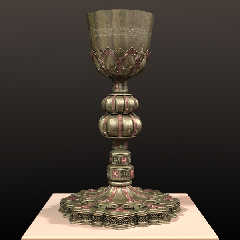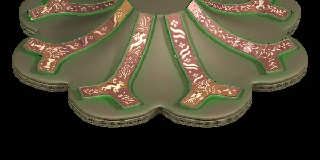 |
 |
|
 |
|
 |
|  |
|  |
|
 |
|
 |
|  |
|  |
|
 |
Beautiful image.
I am following this thread closely because I have been thinking about the
same thing since my image <450bcef5@news.povray.org>. I have no solution to
offer, but the cogs are turning in my brain ;-)
Thomas
Post a reply to this message
|
 |
|  |
|  |
|
 |
|
 |
|  |
|  |
|
 |
"Kirk Andrews" <kir### [at] hotmail com> wrote:
> Ahhh, there's the goal (and I hadn't thought about bird poop, either!). The
> trick is getting that grime *just* in the recesses. Samuel Benge has been
> trying to help me figure out how to do that. If you have any suggestions
> on how that could be done in POV I'd love to hear it.
>
> -- Kirk
Hmm, the way I would do it, is with absorbing media applied to a cylinder
with a radius just a little bit smaller than the column's. Its density
might be (emi-)spherical so the vast majority of the grime would be located
near the bottom.
Nice pic, BTW. I really like the sky, it looks like a "simple" procedural
sky, but simple procedural skies are anything but simple to get right, IMO. com> wrote:
> Ahhh, there's the goal (and I hadn't thought about bird poop, either!). The
> trick is getting that grime *just* in the recesses. Samuel Benge has been
> trying to help me figure out how to do that. If you have any suggestions
> on how that could be done in POV I'd love to hear it.
>
> -- Kirk
Hmm, the way I would do it, is with absorbing media applied to a cylinder
with a radius just a little bit smaller than the column's. Its density
might be (emi-)spherical so the vast majority of the grime would be located
near the bottom.
Nice pic, BTW. I really like the sky, it looks like a "simple" procedural
sky, but simple procedural skies are anything but simple to get right, IMO.
Post a reply to this message
|
 |
|  |
|  |
|
 |
|
 |
|  |
|  |
|
 |
Alain wrote:
> Kirk Andrews nous apporta ses lumieres en ce 2007/06/24 07:03:
>> By "jitter", do you mean a slight amount of
>> turbulence and
>> rotation/translation each time, averaged together?
>>
>> Thanks,
>>
>> Kirk
>>
> That jitter means some small to medium, relative to the dimentions of
> the object, translation of the object pattern, using many instances all
> averaged together. You need at least 10 averaged patterns for this to
> work, and usualy over 100 to get good results. As you don't use
> reflection, it can still be relatively fast, it become painfuly slow if
> you have any reflection, particularly if you have self reflection.
And the pattern you derive from this will need to be encapsulated in a
pigment_pattern{} block, in order to use pigment_maps with it:
pigment{
pigment_pattern{ my_predeclared_jittered_object_pigment }
pigment_map{
[0 some_pigment]
[1 some_other_pigment]
}
}
~Sam
Post a reply to this message
|
 |
|  |
|  |
|
 |
|
 |
|  |
|  |
|
 |
Bill Pragnell wrote:
>
> If you're using an isosurface or other pigment function-based perturbation,
> you should be able to use the same pattern to provide texturing - limit
> your grime textures to the same regions of the colour map as are used for
> the erosion.
Agreed. Pretty much the standard approach.
>The other thing you could try is using the un-weathered base
> object to define an object pattern - only areas inside the object could
> then be textured, i.e. just the weathered sections. I don't know if these
> are practical for your purposes...
I have had some success with this approach also, basically I think I
jittered the object pattern through several minor scale changes. I used
that approach on this chalice image. In the test shot the green shows
where the grime colour would fall.
Post a reply to this message
Attachments:
Download 'img.0132.sm.jpg' (106 KB)
Download 'img.0210.jpg' (40 KB)
Preview of image 'img.0132.sm.jpg'

Preview of image 'img.0210.jpg'

|
 |
|  |
|  |
|
 |
|
 |
|  |
|  |
|
 |
"Kirk Andrews" <kir### [at] hotmail com> wrote:
> I'm working on a scene of some ancient Greece-style ruins. It has proved to
> be very difficult to get everything to look sufficiently weathered and
> "ruined". But here is one of the columns as it stands at the moment. If
> anyone has experience or suggestions in ruining things in POV, I'd love to
> hear them.
>
> - Kirk
I once did broken columns by clipping a regular column with an
iso-landscape. It took some tweaking, but it looked fairly good.
ADB com> wrote:
> I'm working on a scene of some ancient Greece-style ruins. It has proved to
> be very difficult to get everything to look sufficiently weathered and
> "ruined". But here is one of the columns as it stands at the moment. If
> anyone has experience or suggestions in ruining things in POV, I'd love to
> hear them.
>
> - Kirk
I once did broken columns by clipping a regular column with an
iso-landscape. It took some tweaking, but it looked fairly good.
ADB
Post a reply to this message
|
 |
|  |
|  |
|
 |
|
 |
|  |
|  |
|
 |
Jim Charter <jrc### [at] msn com> wrote:
> I have had some success with this approach also, basically I think I
> jittered the object pattern through several minor scale changes. I used
> that approach on this chalice image. In the test shot the green shows
> where the grime colour would fall.
That's a beautiful chalice Jim! Did I miss the original full size image?
Did you use multiple versions scaled differently for the jittered object
pattern, or one version scaled multiple times?
Mark Slone com> wrote:
> I have had some success with this approach also, basically I think I
> jittered the object pattern through several minor scale changes. I used
> that approach on this chalice image. In the test shot the green shows
> where the grime colour would fall.
That's a beautiful chalice Jim! Did I miss the original full size image?
Did you use multiple versions scaled differently for the jittered object
pattern, or one version scaled multiple times?
Mark Slone
Post a reply to this message
|
 |
|  |
|  |
|
 |
|
 |
|  |
|  |
|
 |
Renderdog wrote:
>
> That's a beautiful chalice Jim! Did I miss the original full size image?
Thanks Mark. No, nothing missed. That test render was as far as I took
things. In fact I don't think the render even includes the grunge
effect, that was going to be for a second cut which would have also had
a nice fabric for the display surface. But I lost interest as usual.
Funny, Jaime and others have put fabric capabilities into our hands in a
way that it wasn't when I did the model. Really should finish this one
off. Actually the other necessary component, lighting for such a model,
has also been improved by the efforts of others including Jaime, and I
am learning it on my current project, so maybe I can roll it all
together and make a good final render of that chalice.
>
> Did you use multiple versions scaled differently for the jittered object
> pattern, or one version scaled multiple times?
>
That latter I think.
pigment {
average
pigment_map {
#local I=0;#while(I<90)
[1
object {
object {
k13_texture_
#local J = rand(S);
scale <.9+.2*J,1,.9+.2*J>
}
pigment { rgb CHSL2RGB( <70,.12,.29> ) }
pigment { rgb CHSL2RGB( <65,.24,.08> ) }
}
]
[1
object {
object {
k13_texture_
rotate y*(-10+20*rand(S))
}
pigment { rgb CHSL2RGB( <70,.12,.29> ) }
pigment { rgb CHSL2RGB( <65,.24,.08> ) }
}
]
#local I=I+1;#end
}
}
Post a reply to this message
|
 |
|  |
|  |
|
 |
|
 |
|  |




![]()